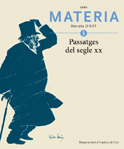The places of memory: Arts as Archive
Abstract
This article centres on a new creative conception of art as archive, developed in the 1960s by a group of artists and art theorists who shared a common interest in the art of individual, cultural and historical memory and who tried to understand the apparently hermetic conceptual system from which they depart. Both literally and metaphorically, the archive is understood as a place in which cultural history is legitimated. Among the genealogical references to art as archive, our study centres on three intellectual projects of the early 20th century:Walter Benjamin’s The Arcades Project, AbyWarburg’s Atlas Mnemosyne, and August Sander’s photographic series. All three projects were unfinished; they eschewed sequentiality and linearity. We also analyse the different artistic uses of the archive in the artists Hans Peter Feldmann, Gerhard Richter, On Kawara, Rosangela Rennó, Fernando Bryce, The Atlas Group, Christian Boltanski, Hanne Darboven, Susan Hiller and Bernd & Hilla Becher.Downloads
Published
2005-01-11
Issue
Section
PASSATGES DEL SEGLE XX
License
The authors who publish in this journal agree to the following terms:
|  |







